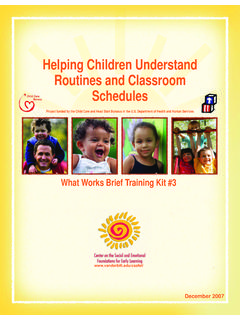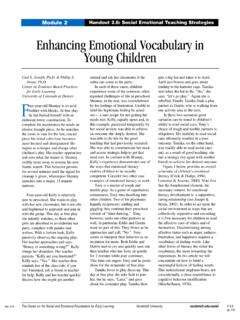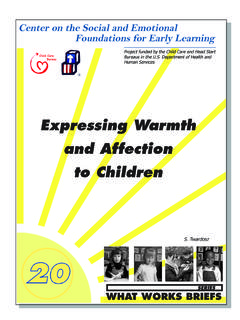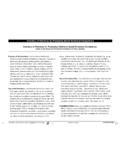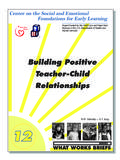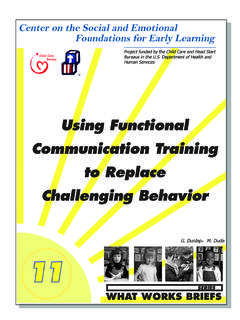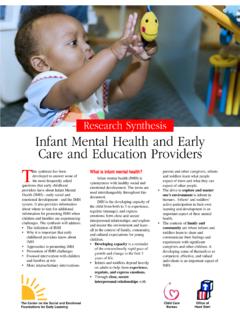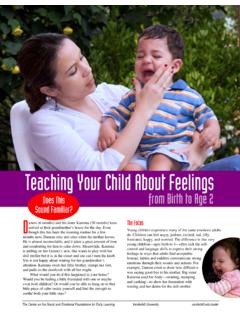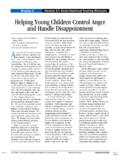Transcription of Using Books to Support Social Emotional Development
1 Glad Monster Sad MonsterBy Ed Emberley & Anne MirandaLittle Brown and Company, 1997 Glad Monster Sad Monsteris a book about feelings with fun monstermasks that children can try on and talk about times when they feltglad, sad, loving, worried, silly, angry and scared just like themonsters! Each monster is a different color to represent specificemotions. For example, the yellow monster is glad when he gets toopen presents, play ball , slurp ice cream and dance with his friend!(Ages 2-5)Examples of activities that can be used while reading Glad Monster Sad Monster andthroughout the day to promote Social and Emotional Development : While reading the story, pause and ask children if they feel the same way the monsters do. Forexample, do they feel glad when they get to play ball like the yellow monster? Ask what otherkinds of things make them feel glad. Do they think the same kinds of things that make themfeel glad would also make yellow monster feel glad?
2 Show the monster masks while reading about each monster and have children talk about howthey can tell what the monster feels by looking at his face. For example, Blue Monster has afrown on his face that makes him look like he might be feeling sad. After reading about each monster, have children try on the monster masks (or make their ownmonster masks and talk about times when they felt glad, sad, silly, etc.) Have children make glad monster/sad monster stick puppets. Give each child 2 blank papercircles (one yellow/one blue). Ask them to draw a glad monster face on the yellow circle and asad monster face on the blue circle . Help them glue their monster faces back to back with apopsicle stick in the middle. Talk about or role play different situations and ask children to holdup their glad monster or sad monster puppet according to how they think the monster wouldfeel. For example, explain that Purple Monster was playing with his favorite truck when RedMonster came and took it away because he wanted to play with it.
3 Ask how they think thatwould make Purple Monster feel. Why? Have children think of other things that Red Monstercould try if he wants to play with Purple Monster s truck. Make a chart that shows each color monster and emotion from the book (yellow/glad,blue/sad, pink/loving, orange/worried, purple/silly, red/angry, green/scared), Encourage eachchild (& teacher!) to put a mark, write their name or place a sticker beside the monster thatshows how they are feeling that day. Ask why they feel that way. With the help of the children, count the number of marks to see how many children feel glad, sad, silly, etc. Talkabout/problem solve what they can do to change the way they feel if they marked that they arefeeling worried or NookUsing Books to Support Social Emotional DevelopmentThe Center on the Social and Emotional Foundations for Early Learning Child Care BureauOffice ofHead Start Book NookReading the same book for several days in a row is a great way to provide opportunities for infants,toddlers, and preschoolers to develop a sense of competence and confidence, which is an importantpart of Social and Emotional Development .
4 They become able to turn pages, point at and labelpictures, talk about the story, predict what will happen next, learn new vocabulary words, talk abouttheir own experiences in relation to the story and even make up their own story! Try reading GladMonster Sad Monsterfor several days in a row and use some of the ideas, activities, and teachingopportunities listed below to enhance Social and Emotional skills. Talk about the monsters in the book. Ask children if they have ever seen a movie or read a differentbook about monsters. How did those monsters make them feel? Refer back to any Books that youhave read in class that had a monster. Ask the children if they can remember some of the emotionsthat the monsters felt in the book. What made the monsters feel this way? Music/Movement:Have children create a name for 2 or 3 different monsters Using feeling words(Hank the Happy Monster, Allie the Angry Monster, Wu-Ying the Worried Monster, Sam the SillyMonster, etc.)
5 Write these on a chart that everyone can see. Together, talk about how each monstermight move. For example, Hank the Happy Monster might skip around and jump for joy, while Alliethe Angry Monster might move by stomping her feet and raising her arms above her head! Create agame by telling the children that when you call out the name of one of the monsters, everyone willmove like that monster. You might want to play monster s background music while you are allmoving like the monsters!Art: Let each child make a feeling monster by Using a paper cup or toilet/paper towel tube andattaching various items to it (yarn, buttons, pipe cleaners, pom poms, ribbon, etc.). Children canmake feeling faces on their monsters and give their monsters a feeling name! Talk to childrenabout their monster what is their monster feeling. Why does their monster feel that way? Whathappened? They can also write a story about their feeling monster and make their own book!
6 Literacy/Writing:Have children create their own Glad Monster Sad Monster Book. Have a copy ofthe book at the literacy/writing center. Remind children how each monster in the book talked aboutactivities or events that made then feel a certain way. Children can pick which emotions they want touse for their book and then draw pictures of the monster as well as pictures of the things that makethem feel that way. For example, children might pick the pink monster (loving), they would drawtheir "loving" monster and then draw things that make them feel loved such as being hugged bymom and dad, baking cookies with grandma, playing ball with dad, reading a book with mom,playing a game with their teacher, playing with their friend Adults can help children write thewords in their book to describe the book nook was developed by Tweety YatesMonsters
